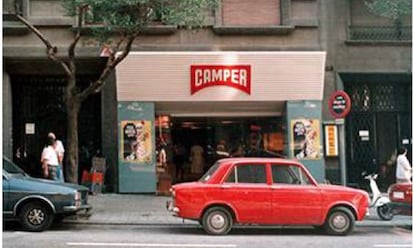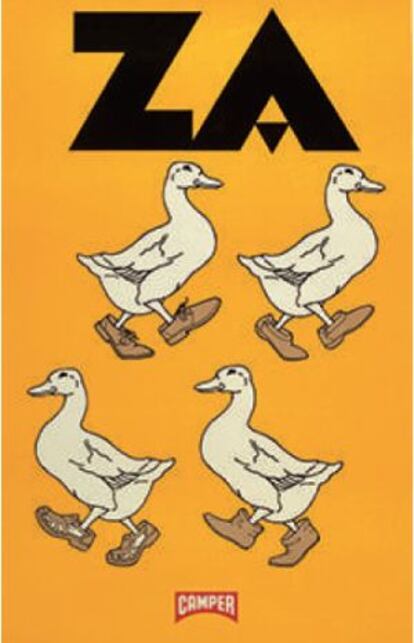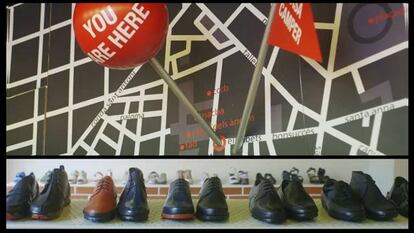Camper’s 40-year stroll to success
London’s Design Museum is dedicating a new show to the renowned Mallorcan shoe brand
It was in 1877 that, barely speaking a word of English, artisan shoemaker Antonio Fluxà left his native Mallorca for Great Britain in order to learn about the latest industrial manufacturing methods. Two years later he returned and brought together the furriers in his hometown of Inca to show them the first shoe-manufacturing machines.
Camper has exploited its image to diversify, opening two hotels and two restaurants
“From then on an industrial revolution got underway on an island whose economic activity was based almost exclusively on agriculture until the arrival, much later, of the tourism industry,” explains Miguel Fluxà, the head of globally renowned shoe brand Camper. Without ever abandoning the shoe-making tradition established by his great-grandfather, the firm has explored new paths that have taken it into the world’s main markets, converting it into a prestigious global brand synonymous with comfort, creativity and design.
So much so that the Design Museum in London is this week opening a major exhibition dedicated to the brand to mark its 40th birthday. Titled Camper: Life on Foot, the show offers a view of the entire process of creating a collection of shoes and exhibits some of its main products, from the first model, the Camaleón, which reinterpreted the traditional shoes worn by Mallorcan farmers, to the Twins, which did away with the symmetry of the pair, via the Pelotas, the firm’s most popular model and the one that has contributed most to its international image. The company exports 80 percent of its production to 60 countries and has around 400 stores worldwide.

So what is the secret of Camper’s success? “The key is design and comfort,” explains Fluxà. “The design sacrifices neither comfort nor quality; then there is also the personality of the shoes, the creativity and the use of a unique language in corporate communication.”
“Walk don’t run” read one of the firm’s most famous advertising slogans. And walking, without ever needing to run, has taken it a long way. “My father [Lorenzo Fluxà] created Camper in 1975, following in the shoe-making tradition of his grandfather but with the spirit of the changing times Spain was going through, which meant incorporating the values of a new lifestyle that have been maintained and evolved over time,” explains Fluxà, a business administration graduate who is himself also about to turn 40.

Over its four-decade history, Camper has collaborated closely with creators from different disciplines, which has given it the image of an artistic and innovative brand. Designers such as Jaime Hayón, the Campana brothers, Javier Mariscal, Oscar Mariné and the Nendo studio; architects such as 2014 Pritzker winner Shigeru Ban, and artists such as Luis Gordillo, among others, have all worked on its products or on the concepts for its stores and hotels. Camper is a shoe brand but it has exploited its image to diversify, opening two hotels (Casa Camper) and two restaurants (Dos Palillos) in Barcelona and Berlin.
Running until November 1, the London exhibition will show how a collection is researched, created and launched, from the design of the shoes themselves, to the box that contains them. It will also explain the manufacturing process and the history of the brand via its best-known models, and it will show sketches and prototypes of both old designs and those that have yet to go on the market, not to mention a selection of the firm’s creative advertising campaigns.
Camper: Life on Foot. Until November 1 at the Design Museum, 28 Shad Thames, London. https://designmuseum.org
Tu suscripción se está usando en otro dispositivo
¿Quieres añadir otro usuario a tu suscripción?
Si continúas leyendo en este dispositivo, no se podrá leer en el otro.
FlechaTu suscripción se está usando en otro dispositivo y solo puedes acceder a EL PAÍS desde un dispositivo a la vez.
Si quieres compartir tu cuenta, cambia tu suscripción a la modalidad Premium, así podrás añadir otro usuario. Cada uno accederá con su propia cuenta de email, lo que os permitirá personalizar vuestra experiencia en EL PAÍS.
¿Tienes una suscripción de empresa? Accede aquí para contratar más cuentas.
En el caso de no saber quién está usando tu cuenta, te recomendamos cambiar tu contraseña aquí.
Si decides continuar compartiendo tu cuenta, este mensaje se mostrará en tu dispositivo y en el de la otra persona que está usando tu cuenta de forma indefinida, afectando a tu experiencia de lectura. Puedes consultar aquí los términos y condiciones de la suscripción digital.
Últimas noticias
Most viewed
- Pablo Escobar’s hippos: A serious environmental problem, 40 years on
- Reinhard Genzel, Nobel laureate in physics: ‘One-minute videos will never give you the truth’
- Why we lost the habit of sleeping in two segments and how that changed our sense of time
- Charles Dubouloz, mountaineering star, retires at 36 with a farewell tour inspired by Walter Bonatti
- The Florida Keys tourist paradise is besieged by immigration agents: ‘We’ve never seen anything like this’










































